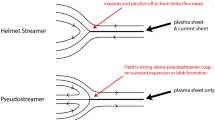Abstract
Hot, X-ray-emitting plasma permeates clusters of galaxies. The X-ray surface brightness often shows a peak near the centre of the cluster that is coincident with a drop in the entropy of the gas. This has been taken as evidence for a ‘cooling flow’, where the gas cools by radiating away its energy, and then falls to the centre1. Searches for this cool gas have revealed significantly less than predicted2, indicating that the mass deposition rate is much lower than expected. Most clusters with cooling flows, however, also host an active galactic nucleus at their centres3. These active galactic nuclei can inflate large bubbles of hot plasma that subsequently rise through the cluster ‘atmosphere’, thus stirring the cooling gas4,5 and adding energy. Here we report highly resolved hydrodynamic simulations which show that buoyant bubbles increase the cooling time in the inner regions of clusters and significantly reduce the deposition of cold gas.



Similar content being viewed by others
References
Fabian, A. C. Cooling flows in clusters of galaxies. Annu. Rev. Astron. Astrophys. 32, 277–318 (1994)
Böhringer, H., Matsushita, K., Churazov, E., Ikebe, Y. & Chen, Y. The new emerging model for the structure of cooling cores in clusters of galaxies. Astron. Astrophys. (submitted); preprint astro-ph/0111112 at 〈http://xxx.lanl.gov〉 (2001)
Burns, J. O. The radio properties of cD galaxies in Abell clusters. I – an X-ray selected sample. Astron. J. 99, 14–30 (1990)
Churazov, E., Forman, W., Jones, C. & Böhringer, H. Asymmetric, arc minute scale structures around NGC 1275. Astron. Astrophys. 356, 788–794 (2000)
Churazov, E., Brüggen, M., Kaiser, C. R., Böhringer, H. & Forman, W. Evolution of buoyant bubbles in M87. Astrophys. J. 554, 261–794 (2001)
Voit, G. M. & Bryan, G. L. Regulation of the X-ray luminosity of clusters of galaxies by cooling and supernova feedback. Nature 414, 425–427 (2001)
Wu, K. K. S., Fabian, A. C. & Nulsen, P. E. J. Non-gravitational heating in the hierarchical formation of X-ray clusters. Mon. Not. R. Astron. Soc. 318, 889–912 (2000)
Heinz, S., Reynolds, C. S. & Begelman, M. C. X-ray signatures of evolving radio galaxies. Astrophys. J. 501, 126–136 (1998)
Kaiser, C. R. & Alexander, P. Heating of the intergalactic medium by FRII radio sources. Mon. Not. R. Astron. Soc. 305, 707–723 (1999)
Reynolds, C. S., Heinz, S. & Begelman, M. C. The hydrodynamics of dead radio galaxies. Mon. Not. R. Astron. Soc. (in the press)
Fabian, A. C. et al. Chandra imaging of the complex X-ray core of the Perseus cluster. Mon. Not. R. Astron. Soc. 318, L65–L68 (2000)
Brüggen, M. & Kaiser, C. R. Buoyant radio plasma in clusters of galaxies. Mon. Not. R. Astron. Soc. 325, 676–684 (2001)
McNamara, B. R. et al. Discovery of ghost cavities in Abell 2597's X-ray atmosphere. Astrophys. J. (submitted); preprint astro-ph/0110554 at 〈http://xxx.lanl.gov〉 (2001)
Brüggen, M., Kaiser, C. R., Churazov, E. & Ensslin, T. A. Simulation of radio plasma in clusters of galaxies. Mon. Not. R. Astron. Soc. (in the press)
Quilis, V., Bower, R. G. & Balogh, M. Bubbles, feedback and the intra-cluster medium: Three-dimensional hydrodynamic simulations. Mon. Not. R. Astron. Soc. 328, 1091–1097 (2001)
Fryxell, B. et al. FLASH: An adaptive mesh hydrodynamics code for modeling thermonuclear flashes. Astrophys. J. Suppl. 131, 273–334 (2000)
Nulsen, P. E. J. & Böhringer, H. A ROSAT determination of the central mass of the Virgo cluster. Mon. Not. R. Astron. Soc. 274, 1093–1106 (1995)
Binney, J. & Tabor, G. Evolving cooling flows. Mon. Not. R. Astron. Soc. 276, 663–678 (1995)
Soker, N., White, R. E., David, L. P. & McNamara, B. R. A moderate cluster cooling flow model. Astrophys. J. 549, 832–839 (2001)
Acknowledgements
The computations reported here were performed using the UK Astrophysical Fluids Facility (UKAFF). The software used in this work was in part developed by the DOE supported ASCI/Alliances Center for Thermonuclear Flashes at the University of Chicago.
Author information
Authors and Affiliations
Corresponding author
Ethics declarations
Competing interests
The authors declare that they have no competing financial interests.
Rights and permissions
About this article
Cite this article
Brüggen, M., Kaiser, C. Hot bubbles from active galactic nuclei as a heat source in cooling-flow clusters. Nature 418, 301–303 (2002). https://doi.org/10.1038/nature00857
Received:
Accepted:
Issue Date:
DOI: https://doi.org/10.1038/nature00857
- Springer Nature Limited
This article is cited by
-
Black holes up close
Nature (2023)
-
Hot Atmospheres, Cold Gas, AGN Feedback and the Evolution of Early Type Galaxies: A Topical Perspective
Space Science Reviews (2019)
-
Constraining Gas Motions in the Intra-Cluster Medium
Space Science Reviews (2019)
-
Metal Enrichment Processes
Space Science Reviews (2008)
-
Science with ASKAP
Experimental Astronomy (2008)





